 I now own a .270 WSM Super Shadow, but I’m not sure why since I’ve ridiculed the stubby cartridge concept ever since Winchester and Remingtonbegan their underachieving magnum arms race. Calculating performance, while varying bore size of the original 300 WSM, suggested the case capacity and aspect ratio of these cartridges would produce exceptional results with a .257″ bore. So I waited and watched as the factories moved in that direction; 300 WSM, 300 SAUM, 7mm WSM, 7MM SAUM, 270 WSM…..243 WSSM? 223 WSSM? I have no idea what happened, but I do know I didn’t get my .257 WSM, or SAUM.
I now own a .270 WSM Super Shadow, but I’m not sure why since I’ve ridiculed the stubby cartridge concept ever since Winchester and Remingtonbegan their underachieving magnum arms race. Calculating performance, while varying bore size of the original 300 WSM, suggested the case capacity and aspect ratio of these cartridges would produce exceptional results with a .257″ bore. So I waited and watched as the factories moved in that direction; 300 WSM, 300 SAUM, 7mm WSM, 7MM SAUM, 270 WSM…..243 WSSM? 223 WSSM? I have no idea what happened, but I do know I didn’t get my .257 WSM, or SAUM.
Finding myself with no excuse to buy a new rifle, I began rationalizing why the .270 WSM might be the right gun for me. There was that gap in my bullet inventory, right between .257″ and .284″, which was probably depriving bullet manufacturers of a much needed source of income. The standard .270 Winchester wouldn’t do; the choice made too much sense, ammo would be inexpensive and there was no chance the cartridge would go obsolete within the next six months. Finally, while I like the .270 Weatherby Magnum, I couldn’t figure out what cartridge was available with which model, “… the Dangerous Duty Pro Shooter Tactical Cut Rifling Marauder is only available in 7mm STW, unless it equipped with a fiberglass stock, in which case it is only chambered for the .44 Russian…” Then I saw an ad for the Winchester Super Shadow 270 WSM, and it spoke to me, “Buy me. I’m new, I’m different and I’m cheap” – So I did.
The Winchester Super Shadow Model 70
The Super Shadow carries an MSRP of $543, I had no problem locating one for $449, or about $100 less. The Super Shadow is priced about halfway between a Remington Model 700 BDL and their low end nylon insert receiver Model 710, or about $200 less than any basic wood stocked Winchester Model 70. The Super Shadow in 270 WSM is, and I apologize for using the cliché, a lot of gun for the money. What can I say? This is the first time I have ever purchased a rifle that I felt was actually a lot of gun for the money.
When I first opened the box, I winced. It is a different looking gun, but when I picked it up, hefted it a bit, pointed it at the computer that had been acting up all morning, the Shadow began to feel pretty good. It has a nice balance and is quick to place on target. I couldn’t figure out why it is called a “Super” Shadow, or even “Shadow” for that matter, or why recent gun magazine articles focused on its controlled round push feed, which isn’t the gun’s significant feature. One thing I do know, given a few minutes, it’s easy to develop an honest appreciation for its appearance, and its cleaver design.
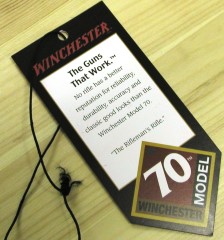
The tag tied to the plastic trigger guard was humorous, although I know that wasn’t the intent. Did Winchester really need to trade mark the slogan “The Gun That Works”? Clearly, someone sat in a marketing department group grope creative meeting, penned those words, then charged me an extra buck so they could print that tag, hang a string on it, and tie it to a gun I had already purchased. I believe I pretty much had expected a working gun.
The “Classic good looks” claim beneath the “Surprise! It Works” slogan was misplaced. Classic firearms do not have sculptured plastic stocks, and oval bumps as a substitute for checkering. I’m not saying the design is unattractive, I am only suggesting it is not a classic design in any respect, except possibly to someone under the age of 12.
The 24″ barrel Super Shadow weighs 6 3/4 lbs on the button, without scope – pretty light. The stock, sans integral frame or pillar bedding, accounts for only 1 1/2 lbs of that total. Accordingly, it would be difficult to hold the gun’s light weight if an owner changed to a fiberglass replacement stock, in an effort to achieve a more traditional appearance. Virtually any replacement fiberglass stock would bump the gun’s weight up by a pound, perhaps more than two if an integral aluminum stock frame and a hinged floor plate were added. Not an issue, the factory stock is more than OK.
The Shadow’s metal parts are a uniform matte anti reflective black. The fiberglass filled molded plastic stock comes with sling swivel studs installed, the trigger guard is plastic, and there is a blind magazine well – even though the stock is molded to give the appearance of a hinged floor plate. This is not a rifle for fancy lads and famous writers, it is a utility rifle made to kill game, requiring little more in maintenance than hosing off mud and applying a light coat of gun oil between hunts. The Super Shadow is designed to endure extreme environmental conditions associated with hunting, and continue to look good and, hopefully, shoot straight.
Poking around under the hood
 Three Phillips head screws; one forward of the magazine, two through the trigger guard, hold the rifle together. This is a fiberglass filled molded stock complete with parting lines that run its length, top and bottom. The recoil pad is wide and comfortable. Photo left is the detail of the trigger guard and false floor plate. The stock is near flat black, the shape and dimensions are excellent and the comb is the right height for a scope. The pull is a little on the short side at 13 1/4″.
Three Phillips head screws; one forward of the magazine, two through the trigger guard, hold the rifle together. This is a fiberglass filled molded stock complete with parting lines that run its length, top and bottom. The recoil pad is wide and comfortable. Photo left is the detail of the trigger guard and false floor plate. The stock is near flat black, the shape and dimensions are excellent and the comb is the right height for a scope. The pull is a little on the short side at 13 1/4″.

The barrel channel and action recess are close fitting with a lot of internal triangular ribbing; forearm left, magazine well right. There is no pillar bedding hardware or a frame, no metal reinforcement at screw holes. The stock feels substantial, even though it is a very light piece, so the geometry of ribs in the design seems to work to make the stock rigid.
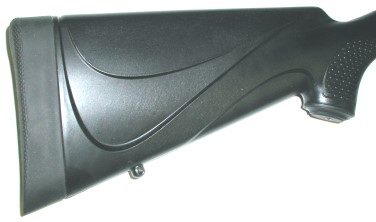 The “mock cheek piece” is actually not a raised cheek piece at all, but rather the result of some very creative recessed sculptured surfaces, designed to keep overall stock weight down while making for a very rigid assembly. The oval bumps on the pistol grip offer as good a grip as traditional line checkering. I’ve carried an uncheckered 336 Marlin around for years and it has never slipped from my hands, so I don’t think any approach in this area really matters.
The “mock cheek piece” is actually not a raised cheek piece at all, but rather the result of some very creative recessed sculptured surfaces, designed to keep overall stock weight down while making for a very rigid assembly. The oval bumps on the pistol grip offer as good a grip as traditional line checkering. I’ve carried an uncheckered 336 Marlin around for years and it has never slipped from my hands, so I don’t think any approach in this area really matters.
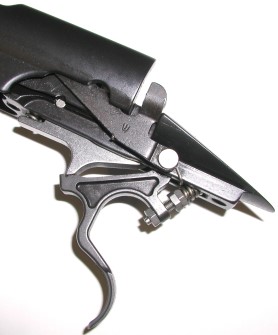
The Shadow utilized a lot of investment cast parts and steel stampings in various assemblies. At first I thought there was a major quality of material difference between the Super Shadow and other recent Model 70 production. I took apart a Model 70 Compact and, other than fineness of finish and a wood stock, the two guns are about equal in quality. The fit and finish of the Shadow remind me of Rugerfirearms. Nothing looks shoddy, but there is a sort of soft edge cast part look to the underside of the receiver, and some stamped steel parts, like the bolt release, that poke out in various places.
My Shadow was received with a small but obvious scratch on the receiver tang, the type of mishandling by factory personnel that always makes me a little crazy. I really prefer to do my own damage to items I purchase. I have a tendency of looking at new rifles and thinking about how I could improve form, fit and function. The Super Shadow was no exception to this exercise, however, there was nothing that looked substandard or in need of replacement from a functional standpoint. I kept thinking this was a rifle I would leave as is and use it for deer hunting in Maine. Outside of handload development, the only remaining preparation for the rifle was to mount a scope, install a sling and do something about its unacceptable trigger pull.
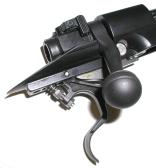
After cleaning and oiling contact surfaces, measured trigger pull was a finger cramp inducing 7 1/4 lbs. Winchester triggers are adjustable for travel and pull, so a couple of 1/4″ wrenches and about 15 minutes to reduce spring preload, was all it took to make a safe adjustment. I set the trigger pull at 5 lbs, a resistance that works best for me in terms of accuracy and safety. The increase of a pound or so over what is frequently suggested seems to help me hold steady and feel more in control of the process. After adjustment, trigger pull was uniform, there was no perceptible creep and the adjustment stayed put. Maybe a $80 aftermarket red or yellow anodized trigger would have added some flash, but clearly no better function.
Sights would be nice
Twenty five years ago, the understanding was that every rifle needed metallic sights. In the event a hunter’s scope went awry whilst being charged by a cape buffalo, the shooter would evidently have enough adrenaline pumping, that he could tear off the scope with his bare hands and use his metallic backup sights to end the threat. Today, metallic sights are considered mostly special equipment on rifles chambered for longer range cartridges, and are frequently provided as an extra cost option. Personally, I can’t see the need for the expenditure. In fact, I literally can’t see most metallic sights anymore, so the fact the Super Shadow has no metallic sights, is of little consequence….actually, of no consequence. A scope was in order.
Setting the Shadow up for the range and handload development
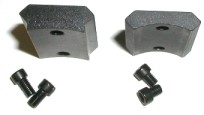 Trying to get tech support from several online suppliers to tell me which model mount systems fit the Super Shadow, was like living in an old episode of the Twilight Zone…I know, what’s a Twilight Zone. It’s sort of like Star Trek, only without a space ship, and much more intelligently written scripts. Cabela’s email guy said there are no mounts for any model WSM as yet. Cabela’s online chat support guy knew better. Brownells did, what Brownells seems to do best these days, and didn’t even bother to respond to the question. Both Warnes and Burris replied quickly, and with correct information -The Super Shadow utilizes standard Winchester two piece bases on .860″ screw centers, the rear and front receiver contours remain the same. Warnes PN S902/924M for steel matte black two piece bases with Torx fasteners. High steel permanent mount high rings for 42mm – 52mm objectives in the same finish are under PN 202M. As is only fair, I purchased from the people who made the effort and ordered both Warne and Weaver systems from Cabela’s.
Trying to get tech support from several online suppliers to tell me which model mount systems fit the Super Shadow, was like living in an old episode of the Twilight Zone…I know, what’s a Twilight Zone. It’s sort of like Star Trek, only without a space ship, and much more intelligently written scripts. Cabela’s email guy said there are no mounts for any model WSM as yet. Cabela’s online chat support guy knew better. Brownells did, what Brownells seems to do best these days, and didn’t even bother to respond to the question. Both Warnes and Burris replied quickly, and with correct information -The Super Shadow utilizes standard Winchester two piece bases on .860″ screw centers, the rear and front receiver contours remain the same. Warnes PN S902/924M for steel matte black two piece bases with Torx fasteners. High steel permanent mount high rings for 42mm – 52mm objectives in the same finish are under PN 202M. As is only fair, I purchased from the people who made the effort and ordered both Warne and Weaver systems from Cabela’s.

The Warnes set up ran about $40, the Weaver set up was $27, and this is one of those times when price is reflected in quality of product. 1- Warnes uses Torx head machine screws that will not pull out or come lose of installed in dry threads and made tight with the small wrench that is included. 2 – Warnes rings are steel and their high ring set is will mount a 50mm scope objective, Weaver’s high rings will not. 3 – Warnes rings have a plated and hardened key that perfectly locates the two ring halves, and locates the rings to a slot machined into the steel bases. 4 – Weaver used a thin stamped steel top ring, claw clamped on one side and secured by two standard machine cross slot screws on the other. Warnes rings are held together by 4 Torx head screws per set. 5 – Weaver rings are held to their bases with a claw on one side and a piece of stamped steel and a screw on the other that also serves to locate the ring fore and aft in the base. Rings that move, or allow a scope to move in recoil have a tendency of killing scopes. $13 is a lot of insurance for a $500 set of optics.
The rest of the package
I don’t think the Super Shadow needs a giant scope with ultra high magnification to be useful, but the rifle is going to spend some time at the range while I develop handloads and collect data, so weight and size was not a primary consideration in my selection of scopes. I decided to go with my Burris Signature 4X-16X scope, with Electro-Dot illuminated reticle, Posi-Locks for the optics, and adjustment for parallax correction. Generally, this scope finds a home on an Ultra lightweight .257 Weatherby.

With 1 1/2 lbs of scope and mounts, plus a 1/4 lb sling, the overall empty weight is 8.5 lbs. Eventually the Shadow will have a scope mount and sling set up that should take this down to 8 lbs even. By comparison, the gun weighs 1/4 lb less than my Weatherby Ultra lightweight. So far, I’m really happy with the rifle. After spending a little time tinkering with it and taking a close look, I think it’s a distinctive firearm with a great deal of potential.
The gun was the easy part
 If I had selected the .270 Winchester, or the .270 WSM there would have been little difference in handloading costs. Bullets are the same, the WSM uses a bit more powder, measured in the scale of a few pennies, and the brass for the WSM is only slightly more costly when measured over its useful life.
If I had selected the .270 Winchester, or the .270 WSM there would have been little difference in handloading costs. Bullets are the same, the WSM uses a bit more powder, measured in the scale of a few pennies, and the brass for the WSM is only slightly more costly when measured over its useful life.
I think there is a good deal more potential in the WSM than is reflected in recent magazine articles. Seating a bullet .400″ into the WSM, Weatherby and standard versions of the 270 Winchester leaves 72 grains, 67 grains and 62 grains of capacity respectively. Theoretically the WSM should have an edge over even the Weatherby, however, most recent reports indicate the Weatherby has the edge. The Weatherby typically has a 26″ barrel, but because the WSM has an almost 1/2″ shorter chamber, the net barrel length difference from the 24″ Winchester is only 1 1/2″. I have no real insight at the moment, but I will very soon.
| Taking on a new cartridge carries some expenses beyond the firearm if the intention is to hand load. In the case of the .270 WSM, there was a set of Hornady loading dies, a shell holder, a bullet puller collet for .277″ bullets, a variety of bullets, and some new unprimed brass. Based on Cabela’s pricing: | 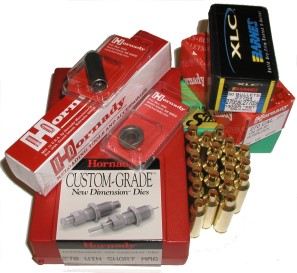 |
||
| Dies | $20.49 | ||
| Shell Holder | 4.99 | ||
| Brass (50) | 14.99 | ||
| Puller collet | 6.29 | ||
| Total | $46.76 | ||
A variety of bullets added $70 to initial costs. I’m not a high priced bullet snob. To the contrary, I am perfectly willing to shoot inexpensive BT Sierra product, but I needed to throw some others in there this time around for the sake of comparison. Next – handloads for the .270 and Super Shadow.
More on the 270 WSM:
The .270 WSM – In pursuit of stubby cartridges
The .270 WSM – In pursuit of stubby cartridges Part 2
The .270 WSM – In pursuit of stubby cartridges – Part 3 – Conclusion
Handload Data – 270 WSM
Thanks
Joe

Email Notification